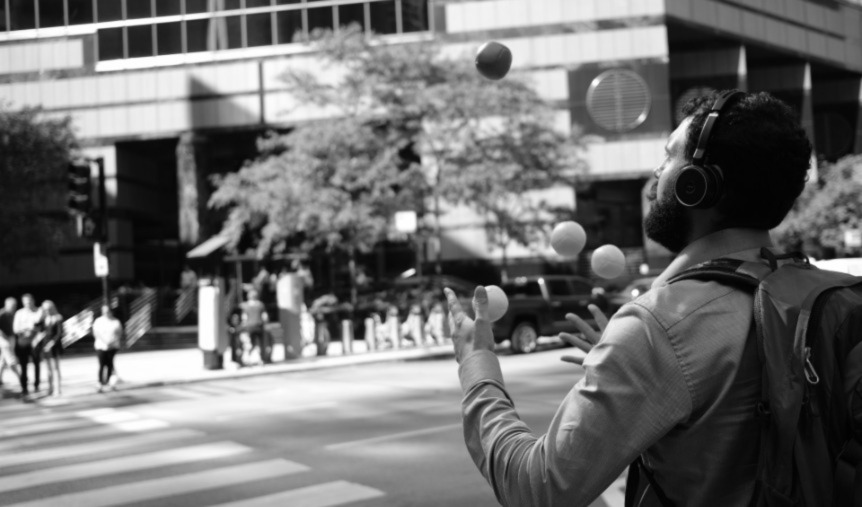BJ Fogg, author of the best-selling book Tiny Habits and founder of the Behavior Design Lab at Stanford University, has spent two decades researching habits. This research led him to propose the Fogg Behavior Model and a framework for change called Behavior Design (or the Tiny Habits method) (Fogg, 2020). Fogg’s methods are not based on guesswork; they’ve been road-tested on more than 60,000 people.
The Fogg Behavior Model
Fogg’s research has shown that all behaviors (B) arise from the same components. All of our habits, whether we label them good, bad or neutral. The components are motivation, ability and prompt. Motivation (M) is our desire to do the behavior. Ability (A) is our capacity to do the behavior. Prompt (P) is our cue to do the behavior. The model can be represented with the simple formula:
B = MAP
“This means behavior occurs when motivation, ability and prompt converge at the same moment,” says Fogg (2020). Figure 1 shows how each of the elements are related to one another.
Figure 1. The Fogg Behavior Model.

No prompt = no behavior
Fogg (2020) reports that we experience hundreds of prompts each day and are largely unaware of them. This matters because prompts are the triggers for our habitual behaviors. Did you want to buy milk on the way home but found yourself walking through your front door without it? There was no prompt so you forgot. If you are trying to break a habit, you can use the relationship “No prompt = no behavior” to your advantage (more on this later).
The next point to consider is do prompts always work? It turns out that the answer is “No.” We only respond reliably to prompts when they appear above the Action Line, that is, when we are sufficiently motivated and able.
Motivation and ability have a compensatory relationship
Fogg argues that motivation and ability have a compensatory relationship. This means the more you have of one, the less you need of the other. When our motivation is low we need to find a behavior easy to do to appear above the Action Line. To find a behavior easy requires high ability. In other words, when our motivation is low, we need high ability for a prompt to work.
By contrast, if our motivation is high, we need less ability to fall into the region above the Action Line. That is, when our motivation is high, we can do more difficult things when prompted.
Behavior design
So, what does all of this mean for behavior design? The beauty of the Fogg Behavior model is that it makes it easy for us to predict whether a solution is going to work, whether it be one designed to form a new, productive habit, or quit an existing, unproductive one. The easier a behavior is to do, the more likely it is that we will do it, repeat it, and form a habit. This process is the same for good habits and bad.
There is no universal solution for every behavior challenge. Our job is to adjust the components – M, A and P – to find the sweet spot. Behaviors that eventually become habits are those that consistently fall above the Action Line. We break habits by tweaking the components to consistently fall below the Action Line.
Applying these insights
This activity is adapted from an exercise Fogg designed to help people disrupt an unwanted habit (Fogg, 2020).
- Choose one bad habit you’d like to break.
- Identify the prompt for this behavior. Think of ways you could remove or avoid the prompt. If nothing comes to mind, move on to the next step.
- Brainstorm ways to make this behavior harder to do, thus changing your ability to perform the habit. If you can’t think of any possibilities, move on to the next step.
- Think of ways to lessen your motivation to do this habit. What would reduce your desire?
- Select an option you would actually be willing to try. Choose options as early in the sequence as possible (prompts over ability over motivation).
- Follow through by trialing your option. If it doesn’t work, repeat the process starting back at step 2. Fogg advises that experimenting is an important aspect of behavior design. Each person’s motivation, ability and prompts are different. And they can change, depending on the situation.
An example in action
Step 1: Let’s say you’re suffering financial stress from frequent, impulsive spending. This is a habit you’d like to break.
Step 2: You consider when and where you make unplanned purchases. Often it’s in response to a notification on your phone that a favorite store is having a sale. You decide to delete the app and unsubscribe from all emails so you will receive no future prompts in relation to enticing sales.
At the end of the month, you notice you have more money left in your checking account than usual. Win! But – you haven’t fully kicked the habit as you’ve bought a few items that attracted buyer’s remorse. You realize that when you’ve had a particularly hard day at work, you tend to swing by the mall on the way home for some retail therapy. In this case it’s not so easy to remove the prompt (a difficult day at work), so you move on to Step 3.
Step 3: You begin to brainstorm ways to make this behavior (driving to the mall on the way home) more difficult. A few options include: carpooling so you’re no longer the driver, scheduling important appointments immediately after work so there is no time to shop on the way home, and cutting up your credit cards so it’s more challenging to pay for items.
Step 4: You decide that none of the options above are feasible, so it’s time to consider motivation. You search for the underlying cause of the impulse buying and draw the conclusion it is usually to reduce feelings of stress rather than a true desire for the product itself. You make a list of alternative activities you could do when feeling stressed that you really enjoy such as going for a walk, phoning a friend, taking a bath and meditating.
Step 5: You decide on phoning a friend as it’s something you’re likely to actually do. You put a Post-it note with the words “If you’re stressed, call Rebecca on your drive home” on your car dashboard.
Step 6: One day at work, not long after making this decision, you have an extremely busy day due to several colleagues being off sick. By the time you’re walking back to your car, your stress levels are through the roof. After buckling in, you see the Post-it note and this prompts you to phone Rebecca (hands-free). Your best friend is a great distraction on the drive and you arrive home feeling in a much better mood due to sharing a few laughs. A few hours later you realize that this is when you would normally be feeling guilty, having just arrived back from the mall with purchases you can’t really afford. This realization makes you feel even better.
Troubleshooting
If your current strategy for breaking a bad habit isn’t working, it could be that you’ve started with the most difficult component – motivation. Start with the prompt or your ability to carry out the habitual behavior instead. You might be surprised to discover an easier path.
Related Articles:
Reference:
- Fogg, B. (2020). Tiny Habits. Virgin Books.



